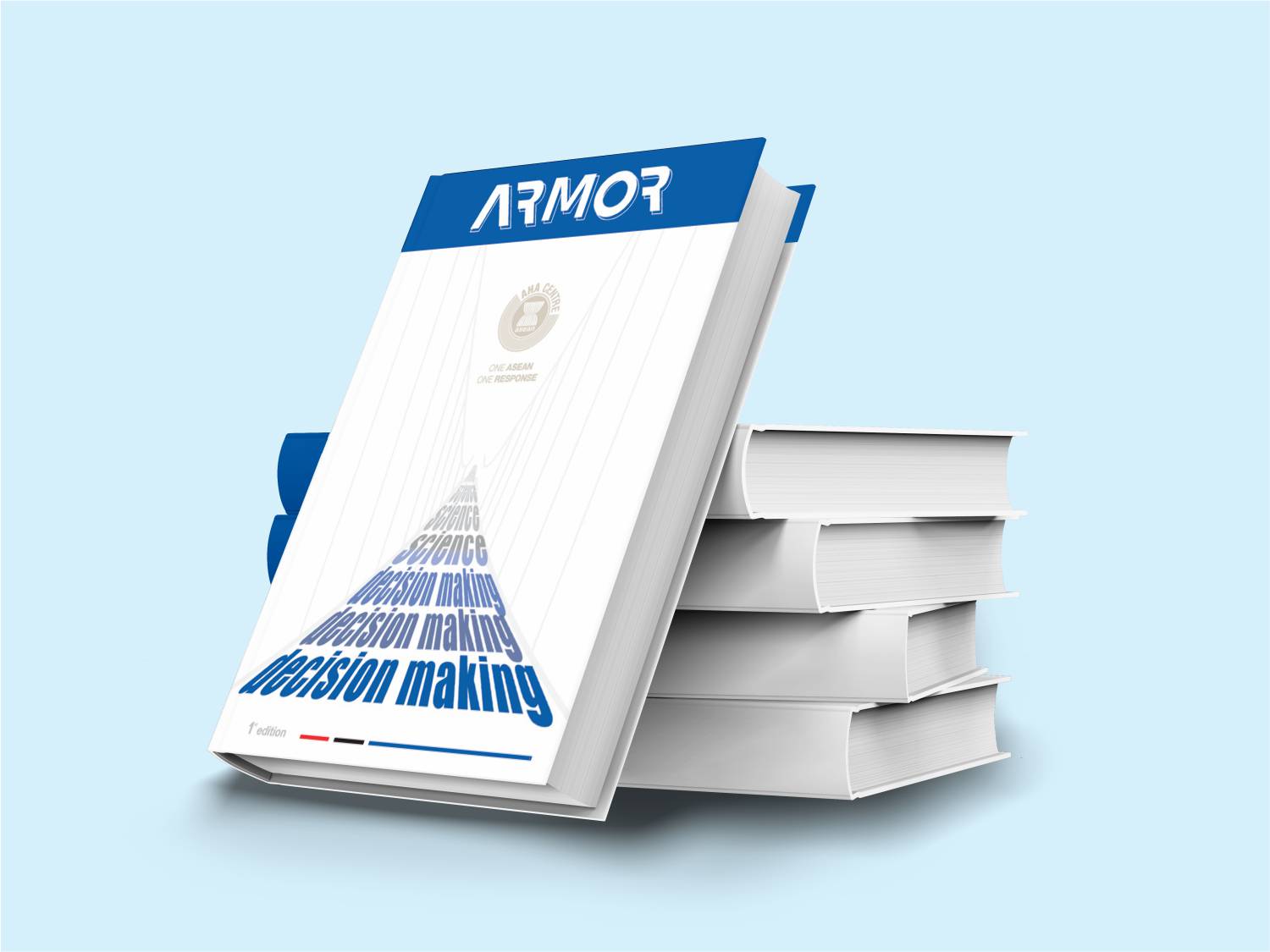
BOOK REVIEW:
THE ASEAN RISK MONITOR AND DISASTER MANAGEMENT REVIEW
(ARMOR)
As covered in Volume 49 of the Column, the AHA Centre’s publication and launch of the ASEAN Risk Monitor and Disaster Management Review (ARMOR) recently took place, with the publication aiming to bridge science with decision making in the region’s disaster management field. The journal, made-up of 10 unique chapters, stands as the first publication of its kind providing risk profile information specifically regarding the ASEAN region. As the sheer amount of accumulated knowledge and information on disaster in the region continues to grow, the first ARMOR publication opens a forum for critical analysis and synthesis of such information, aiming to inform policy making and disaster management operations, both within the region and outside. Importantly, the first edition also highlights best practices, trends and innovations in ASEAN disaster management, and provides the platform for further expansion of current ideas as well as facilitating a space for new considerations from some of the region’s leading disaster management minds.
NEW AND UNIQUE INSIGHTS
One of the stand-out features from ARMOR’s first edition is the range of new, innovative and unique information it provides regarding disaster management in the region. A modern and unique theme is raised in Chapter Five, as the authors take readers through the context of Natech: The Silent and Potentially Deadly Threat in ASEAN, that discusses the growing potential risk of Natech (technological incidence/disasters triggered by natural hazards) in ASEAN, and how the region can work to mitigate such risks. Such an area is becoming increasingly relevant as the region continues to develop, with the risks related to technological disaster due to natural hazards increasing alongside the increasing numbers of factories, hazardous material sites and technology-based infrastructure throughout ASEAN’s landscape.
Chapter Two (Most-at-Risk Cities in ASEAN That Must be Watched) also gives the readers a fresh update regarding research findings on risk of disaster for ASEAN cities, with new and updated data leading to some interesting and unexpected findings – some of which challenge traditional perceptions regarding disaster management in the region. Similar findings and unique circumstances are also delivered in Chapter One Trillion Dollar Multi-Hazard Risk Landscape in Southeast Asia article. An interesting discussion on Utilisation of Space-based Information for Supporting Emergency Response and Recovery takes place through Chapter 10, with the article developed based on actual emergency response experiences that utilised space-based information, alongside direct field observation, to inform operational decision making.
THE ASEAN REGION’S PROGRESS IN DISASTER MANAGEMENT
A key strength of ARMOR is its delivery of information related to the ‘state-of-play’ for disaster management in the ASEAN region. We are provided with a strong insight into the relevant topic of climate change and its impact on areas such as water, food and health security during disaster, with Chapter Three focused on Why Climate Change Matters for ASEAN. The conversation on early warning systems and their use and impact for ASEAN is also highlighted, with Chapter Five providing analysis and a snapshot of the State of Early Warning Systems in ASEAN. ARMOR also provides focus to the AHA Centre itself, particularly the opportunities for the AHA Centre to fully realise its role as a knowledge hub for disaster management. This interesting insight is covered through in Chapter Seven’s Regional Knowledge Hub for Disaster Management: Strategy, Policy and Practice in ASEAN, followed-on directly with Chapter Eight discussing the evolving roles of the AHA Centre in Regional Centrality and the Shift of Humanitarian Landscape: The Case of ASEAN. Such information is developed by analysing and comparing two uniquely different emergency response operations – super typhoon Haiyan and the earthquake and tsunami in Central Sulawesi – providing readers not only a historical insight to the change that has evolved over time, but also the key areas in which the AHA Centre has established its role within the regional disaster management landscape.
KNOWLEDGE THAT CROSSES GENERATIONS
A great aspect of this ARMOR edition is the array of input from researchers and professionals covering different generations and skillsets, ensuring that the full scope of ASEAN disaster management is encompassed within the 10 chapters. We learn about the history of ASEAN disaster management and lessons learned through Achieving the ASEAN 2025 Vision for Disaster Management: Lessons from a Worthy Journey in Chapter Nine – a piece developed by seasoned researchers Alistair D. B. Cook and Lina Gong. In contrast, one of ASEAN’s up-and-coming disaster researchers, Juwita Nirmalasari, proposes an innovative way to accurately and immediately identify drought events that can be utilised by policy makers to engage in early and significant interventions, as the guest contributor in Chapter Six titled Application of Breaks for Additive Season and Trend (BFAST) for Drought Monitoring. This range of elements, mix of modern and historical outlooks, and the array of experiences and backgrounds provides balance and space for innovation throughout the entire journal. In reality, it represents how the ASEAN disaster management sector should be perceived throughout all of its efforts – combining experience and lessons learned based on research and data, while remaining open and ready to embrace new technology and innovative ideas from new generations of disaster managers moving through the ranks.
Written by : William Shea

